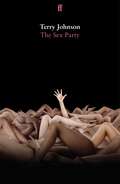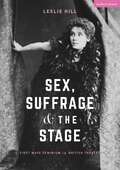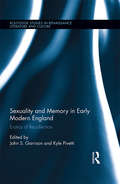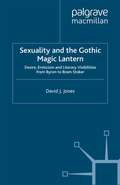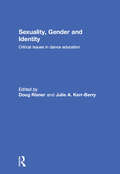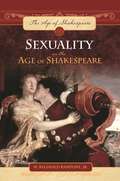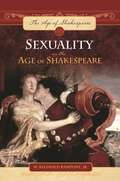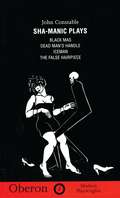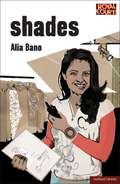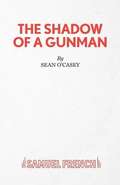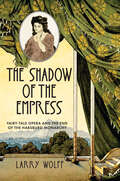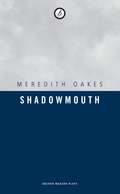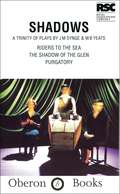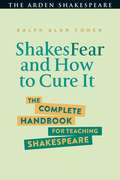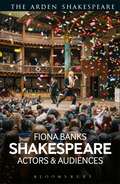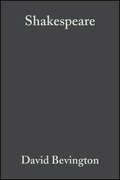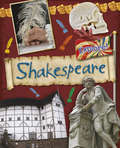- Table View
- List View
The Sex Party
by Terry JohnsonWell yes and no. It's sexy, but pedestrian. Hieronymus Bosch in Smethwick. Hetty and I found a little alcove with our Sauvignon.Four couples gather in a suburban London home for a night of wine, cheese, and more intimate pleasures. Some are curious newcomers, some are old hands, but one guest takes them all by surprise. Thus an evening full of promise is poised to go beyond anyone's expectations.Terry Johnson's The Sex Party premiered at the Menier Chocolate Factory, London, in November 2022.
Sex, Suffrage and the Stage: First Wave Feminism in British Theatre
by Leslie HillMarking the 100-year anniversary of women's suffrage, Leslie Hill provides a fascinating survey of the history of first wave feminism in British theatre, from the London premiere of Ibsen's A Doll's House in 1889 through the militant suffrage movement. Hill's approachable overview explores some of the pivotal ways in which theatre makers both engaged with and influenced feminist discourse on topics such as sexual agency, reproductive rights, marriage equality, financial independence and suffrage.Clear and concise, this is an ideal resource for undergraduate and postgraduate students of theatre and performance studies taking courses on Women in Theatre and Performance, Staging Feminism, Early Feminist Theatre, Theatre and Suffrage, Gender and Theatre, Political Theatre and Performance Historiography. This text will also appeal to scholars, lecturers, and Literature students.
Sex, Suffrage and the Stage (PDF): First Wave Feminism in British Theatre
by Leslie HillThis engaging textbook marks the 100 year anniversary of women’s suffrage by reflecting on the idea and representation of ‘woman’ in British drama and theatre from the 1890s until the First World War. Providing an accessible overview of early feminist theatre history, Leslie Hill foregrounds key characters created and issues debated on stage by prominent dramatists such as George Bernard Shaw, Elizabeth Robins, Oscar Wilde and Arthur Wing Pinero. Clear and concise, this is an ideal resource for undergraduate and postgraduate students of Theatre and Performance Studies taking courses on Women in Theatre and Performance, Staging Feminism, Early Feminist Theatre, Theatre and Suffrage, Gender and Theatre, Political Theatre and Performance Historiography. This text will also appeal to scholars, lecturers, and Literature students.
Sexuality and Memory in Early Modern England: Literature and the Erotics of Recollection (Routledge Studies in Renaissance Literature and Culture)
by John S. Garrison Kyle PivettiThis volume brings together two vibrant areas of Renaissance studies today: memory and sexuality. The contributors show that not only Shakespeare but also a broad range of his contemporaries were deeply interested in how memory and sexuality interact. Are erotic experiences heightened or deflated by the presence of memory? Can a sexual act be commemorative? Can an act of memory be eroticized? How do forms of romantic desire underwrite forms of memory? To answer such questions, these authors examine drama, poetry, and prose from both major authors and lesser-studied figures in the canon of Renaissance literature. Alongside a number of insightful readings, they show that sonnets enact a sexual exchange of memory; that epics of nationhood cannot help but eroticize their subjects; that the act of sex in Renaissance tragedy too often depends upon violence of the past. Memory, these scholars propose, re-shapes the concerns of queer and sexuality studies – including the unhistorical, the experience of desire, and the limits of the body. So too does the erotic revise the dominant trends of memory studies, from the rhetoric of the medieval memory arts to the formation of collective pasts.
Sexuality and Memory in Early Modern England: Literature and the Erotics of Recollection (Routledge Studies in Renaissance Literature and Culture)
by John S. Garrison Kyle PivettiThis volume brings together two vibrant areas of Renaissance studies today: memory and sexuality. The contributors show that not only Shakespeare but also a broad range of his contemporaries were deeply interested in how memory and sexuality interact. Are erotic experiences heightened or deflated by the presence of memory? Can a sexual act be commemorative? Can an act of memory be eroticized? How do forms of romantic desire underwrite forms of memory? To answer such questions, these authors examine drama, poetry, and prose from both major authors and lesser-studied figures in the canon of Renaissance literature. Alongside a number of insightful readings, they show that sonnets enact a sexual exchange of memory; that epics of nationhood cannot help but eroticize their subjects; that the act of sex in Renaissance tragedy too often depends upon violence of the past. Memory, these scholars propose, re-shapes the concerns of queer and sexuality studies – including the unhistorical, the experience of desire, and the limits of the body. So too does the erotic revise the dominant trends of memory studies, from the rhetoric of the medieval memory arts to the formation of collective pasts.
Sexuality and the Gothic Magic Lantern: Desire, Eroticism and Literary Visibilities from Byron to Bram Stoker (Palgrave Gothic)
by D. JonesThis fascinating study explores the multifarious erotic themes associated with the magic lantern shows, which proved the dominant visual medium of the West for 350 years, and analyses how the shows influenced the portrayals of sexuality in major works of Gothic fiction.
Sexuality, Gender and Identity: Critical Issues in Dance Education
by Doug Risner and Julie A. Kerr-BerrySexuality is a difficult topic for all educators. Dance teachers and educators are not immune to these educational challenges, especially given the large number of children, adolescents, and young adults who pursue dance study and performance. Most troubling is the lack of serious discourse in dance education and the development of educative strategies to promote healthy sexuality and empowered gender identities in proactive ways. This volume, focused on sexuality, gender, and identity in dance education, expands this developing area of study and investigates diverse perspectives from public schools, private sector dance studios and schools, as well as college and university dance programs. By openly bringing issues of sexuality and gender to the forefront of dance education and training, this book straightforwardly addresses critical challenges for engaged educators interested in age appropriate content, theme and costume; the hyper-sexualization of children and adolescents; sexual orientation and homophobia; the hidden curriculum of sexuality and gender; sexual identity; the impact of contemporary culture; and mass media, and sexual exploitation. The original research provides a frank discussion, highlighting practical applications and offering insights and recommendations for today’s educational environment in dance. This book was originally published as a special issue of the Journal of Dance Education.
Sexuality, Gender and Identity: Critical Issues in Dance Education
by Doug Risner Julie Kerr-BerrySexuality is a difficult topic for all educators. Dance teachers and educators are not immune to these educational challenges, especially given the large number of children, adolescents, and young adults who pursue dance study and performance. Most troubling is the lack of serious discourse in dance education and the development of educative strategies to promote healthy sexuality and empowered gender identities in proactive ways. This volume, focused on sexuality, gender, and identity in dance education, expands this developing area of study and investigates diverse perspectives from public schools, private sector dance studios and schools, as well as college and university dance programs. By openly bringing issues of sexuality and gender to the forefront of dance education and training, this book straightforwardly addresses critical challenges for engaged educators interested in age appropriate content, theme and costume; the hyper-sexualization of children and adolescents; sexual orientation and homophobia; the hidden curriculum of sexuality and gender; sexual identity; the impact of contemporary culture; and mass media, and sexual exploitation. The original research provides a frank discussion, highlighting practical applications and offering insights and recommendations for today’s educational environment in dance. This book was originally published as a special issue of the Journal of Dance Education.
Sexuality in the Age of Shakespeare (The Age of Shakespeare)
by W. Reginald Jr.This book examines the important themes of sexuality, gender, love, and marriage in stage, literary, and film treatments of Shakespeare's plays.The theme of sexuality is often integral to Shakespeare's works and therefore merits a thorough exploration.Sexuality in the Age of Shakespeare begins with descriptions of sexuality in ancient Greece and Rome, medieval England, and early-modern Europe and England, then segues into examinations of the role of sexuality in Shakespeare's plays and poetry, and also in film and stage productions of his plays. The author employs various theoretical approaches to establish detailed interpretations of Shakespeare's plays and provides excerpts from several early-modern marriage manuals to illustrate the typical gender roles of the time. The book concludes with bibliographies that students of Shakespeare will find invaluable for further study.
Sexuality in the Age of Shakespeare (The Age of Shakespeare)
by W. Reginald Jr.This book examines the important themes of sexuality, gender, love, and marriage in stage, literary, and film treatments of Shakespeare's plays.The theme of sexuality is often integral to Shakespeare's works and therefore merits a thorough exploration.Sexuality in the Age of Shakespeare begins with descriptions of sexuality in ancient Greece and Rome, medieval England, and early-modern Europe and England, then segues into examinations of the role of sexuality in Shakespeare's plays and poetry, and also in film and stage productions of his plays. The author employs various theoretical approaches to establish detailed interpretations of Shakespeare's plays and provides excerpts from several early-modern marriage manuals to illustrate the typical gender roles of the time. The book concludes with bibliographies that students of Shakespeare will find invaluable for further study.
Sh!t Theatre Drink Rum with Expats (Oberon Modern Plays)
by Rebecca Biscuit Louise MothersoleIn 2018, island-monkeys Becca and Louise got invited to Valletta, the European Capital of Culture in Malta. They thought they were going to drink rum with Brits abroad, celebrating their final year as Europeans, and make a play. Instead they found corruption, hypocrisy, and murder in the fight to be European. Blending investigative journalism with live art, Drinking Rum is more than just another excuse for the multi-award winning Sh!t Theatre to get drunk on stage.
Sha-Manic Plays: Black Mas; Iceman; False Hairpiece; Dead Man's Handle (Oberon Modern Plays)
by John ConstableIncludes the plays; Black Mas, Iceman, The False Hairpiece, and Dead Man's Handle.Four darkly mysterious plays with a shamanic theme by one of Britain’s most offbeat playwrights.
Shades (Modern Plays)
by Alia Bano'How religious are you? I never know how to answer that question. I mean how do you measure religiousness?' London worships many gods, but it often seems that Cupid isn't one of them. Sabrina, a single girl-about-town, is seeking Mr Right in a world where traditional and liberal brothers sit side-by-side, but rarely see eye-to-eye.Shades explores tolerance within and without the Muslim community. A programme text edition published to coincide with the world premiere at the Royal Court Theatre, London, on 28 January 2009.
Shades: Eden's Empire; Alaska; A Day At The Racists; Shades; The Westbridge (Modern Plays)
by Alia Bano'How religious are you? I never know how to answer that question. I mean how do you measure religiousness?' London worships many gods, but it often seems that Cupid isn't one of them. Sabrina, a single girl-about-town, is seeking Mr Right in a world where traditional and liberal brothers sit side-by-side, but rarely see eye-to-eye.Shades explores tolerance within and without the Muslim community. A programme text edition published to coincide with the world premiere at the Royal Court Theatre, London, on 28 January 2009.
Shadow Of A Gunman (PDF)
by Sean O'CaseyDonal Davoren and Seumas Shields are room-mates in a Dublin tenement. For no particular reason Donal is looked upon by the other residen's of the tenement as being a gunman in the'service of the Irish Republican Party, but he is merely a dreaming poet who rather enjoys the mystery that has been built up around him. One of the Republicans calls on Donal and Seumas and leaves a bag containing bombs in their room. When the house is raided by the authorities, Minnie Powell, a friend, offers to hide the bag in her room, never dreaming that they would search her. But the deed is discovered, and Minnie, in trying to resist arrest, is shot.
The Shadow of the Empress: Fairy-Tale Opera and the End of the Habsburg Monarchy
by Larry WolffA beguiling exploration of the last Habsburg monarchs' grip on Europe's historical and cultural imagination. In 1919 the last Habsburg rulers, Emperor Karl and Empress Zita, left Austria, going into exile. That same year, the fairy-tale opera Die Frau ohne Schatten (The Woman Without a Shadow), featuring a mythological emperor and empress, premiered at the Vienna Opera. Viennese poet Hugo von Hofmannsthal and German composer Richard Strauss created Die Frau ohne Schatten through the bitter years of World War I, imagining it would triumphantly appear after the victory of the German and Habsburg empires. Instead, the premiere came in the aftermath of catastrophic defeat. The Shadow of the Empress: Fairy-Tale Opera and the End of the Habsburg Monarchy explores how the changing circumstances of politics and society transformed their opera and its cultural meanings before, during, and after the First World War. Strauss and Hofmannsthal turned emperors and empresses into fantastic fairy-tale characters; meanwhile, following the collapse of the Habsburg monarchy after the war, their real-life counterparts, removed from political life in Europe, began to be regarded as anachronistic, semi-mythological figures. Reflecting on the seismic cultural shifts that rocked post-imperial Europe, Larry Wolff follows the story of Karl and Zita after the loss of their thrones. Karl died in 1922, but Zita lived through the rise of Nazism, World War II, and the Cold War. By her death in 1989, she had herself become a fairy-tale figure, a totem of imperial nostalgia. Wolff weaves together the story of the opera's composition and performance; the end of the Habsburg monarchy; and his own family's life in and exile from Central Europe, providing a rich new understanding of Europe's cataclysmic twentieth century, and our contemporary relationship to it.
The Shadow of the Empress: Fairy-Tale Opera and the End of the Habsburg Monarchy
by Larry WolffA beguiling exploration of the last Habsburg monarchs' grip on Europe's historical and cultural imagination. In 1919 the last Habsburg rulers, Emperor Karl and Empress Zita, left Austria, going into exile. That same year, the fairy-tale opera Die Frau ohne Schatten (The Woman Without a Shadow), featuring a mythological emperor and empress, premiered at the Vienna Opera. Viennese poet Hugo von Hofmannsthal and German composer Richard Strauss created Die Frau ohne Schatten through the bitter years of World War I, imagining it would triumphantly appear after the victory of the German and Habsburg empires. Instead, the premiere came in the aftermath of catastrophic defeat. The Shadow of the Empress: Fairy-Tale Opera and the End of the Habsburg Monarchy explores how the changing circumstances of politics and society transformed their opera and its cultural meanings before, during, and after the First World War. Strauss and Hofmannsthal turned emperors and empresses into fantastic fairy-tale characters; meanwhile, following the collapse of the Habsburg monarchy after the war, their real-life counterparts, removed from political life in Europe, began to be regarded as anachronistic, semi-mythological figures. Reflecting on the seismic cultural shifts that rocked post-imperial Europe, Larry Wolff follows the story of Karl and Zita after the loss of their thrones. Karl died in 1922, but Zita lived through the rise of Nazism, World War II, and the Cold War. By her death in 1989, she had herself become a fairy-tale figure, a totem of imperial nostalgia. Wolff weaves together the story of the opera's composition and performance; the end of the Habsburg monarchy; and his own family's life in and exile from Central Europe, providing a rich new understanding of Europe's cataclysmic twentieth century, and our contemporary relationship to it.
Shadowmouth: Collected Plays (the Neighbour, The Editing Process, Faith, Her Mother And Bartok, Shadowmouth, Glide, The Mind Of The Meeting) (Oberon Modern Plays)
by Meredith OakesLove, loneliness and longing in the twilight hours - in cities which never sleep, night hawks are falling in love, out of love and over the edge. Inspired by the photography of Nan Goldin, Shadowmouth is about people trying to connect in a landscape of disconnection, the power of desire, and being alone late at night. Combining hypnotic language with arresting dance theatre, this bold and thrillingly new show salutes the underbelly of urban life.
Shadows: A Trinity of Plays (Oberon Modern Plays)
by J. M. SyngeA collection of three classic Irish one-act plays, as produced on the RSC’s highly successful 1998 tour. Richly passionate, poetic and violent, the plays reveal our fascination with death and transendance. Features the plays Riders to the Sea, The Shadow of the Glen and Purgatory, with an introduction by Declan Kiberd.
ShakesFear and How to Cure It: The Complete Handbook for Teaching Shakespeare
by Ralph Alan CohenFor teachers and lovers of Shakespeare, ShakesFear and How to Cure It provides a comprehensive approach to the challenge and rewards of teaching Shakespeare and gives teachers both an overview of each of Shakespeare's 38 plays and specific classroom tools for teaching it. Written by a celebrated teacher, scholar and director of Shakespeare, it shows teachers how to use the text to make the words and the moments come alive for their students. It refutes the idea that Shakespeare's language is difficult and provides a survey of the plays by someone who has lived intimately with them on the page and on the stage.
ShakesFear and How to Cure It: The Complete Handbook for Teaching Shakespeare
by Ralph Alan CohenFor teachers and lovers of Shakespeare, ShakesFear and How to Cure It provides a comprehensive approach to the challenge and rewards of teaching Shakespeare and gives teachers both an overview of each of Shakespeare's 38 plays and specific classroom tools for teaching it. Written by a celebrated teacher, scholar and director of Shakespeare, it shows teachers how to use the text to make the words and the moments come alive for their students. It refutes the idea that Shakespeare's language is difficult and provides a survey of the plays by someone who has lived intimately with them on the page and on the stage.
Shakespeare: Actors and Audiences
by Fiona BanksShakespeare: Actors and Audiences brings together the voices of those who make productions of Shakespeare come to life. It shines a spotlight on the relationship between actors and audiences and explores the interplay that makes each performance unique. We know much about theatre in Shakespeare's time but very little about the audiences who attended his plays. Even today the audience's voice remains largely ignored. This volume places the role of the audience at the centre of how we understand Shakespeare in performance. Part One offers an overview of the best current audience research and provides a critical framework for the interviews and testimony of leading actors, theatre makers and audience members that follow in Part Two, including Juliet Stevenson and Emma Rice. Shakespeare: Actors and Audiences offers a fascinating insight into the world of theatre production and of the relationship between actor and audience that lies at the heart of theatre-making.
Shakespeare: Actors and Audiences
by Fiona BanksShakespeare: Actors and Audiences brings together the voices of those who make productions of Shakespeare come to life. It shines a spotlight on the relationship between actors and audiences and explores the interplay that makes each performance unique. We know much about theatre in Shakespeare's time but very little about the audiences who attended his plays. Even today the audience's voice remains largely ignored. This volume places the role of the audience at the centre of how we understand Shakespeare in performance. Part One offers an overview of the best current audience research and provides a critical framework for the interviews and testimony of leading actors, theatre makers and audience members that follow in Part Two, including Juliet Stevenson and Emma Rice. Shakespeare: Actors and Audiences offers a fascinating insight into the world of theatre production and of the relationship between actor and audience that lies at the heart of theatre-making.
Shakespeare: The Seven Ages of Human Experience
by David BevingtonThe extended second edition of this inspiring introduction to Shakespeare offers readers more insights into what makes Shakespeare great, and why we still read and perform his works. A highly innovative introduction to the extraordinary phenomenon of Shakespeare Explores Shakespeares works through the "Seven Ages of Man", from childhood to "second childishness and mere oblivion" Now includes more material on fathers and sons, the perils of courtship, the circumstances of Shakespeares own life, the performance history of his plays on stage and on screen, and more A new final chapter on "Shakespeare Today" looks at the remarkable diversity of interpretations in modern criticism and performance of Shakespeare Discusses a wide range of plays and poems Suitable for both non-specialist readers, and scholars seeking a fresh approach to the study of Shakespeare
Shakespeare: Shakespeare (Explore! #11)
by Jane BinghamThis photographic book gives you an overview of Shakespeare and the time that he lived in. From his upbringing and family life, to his world famous plays and the Globe Theatre. Learn about the world in the time of Shakespeare from London and England to the wider world. You can read about a day in the life of a boy actor, and even learn how to make your own model theatre.
